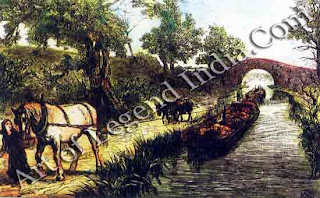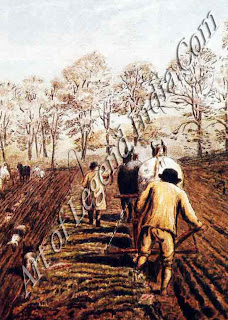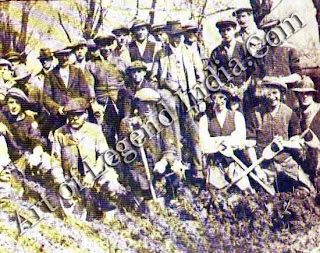Constable's
Suffolk
 Constable painted Suffolk in its golden
age, when high farm prices brought boom years for farmers. But country life was
changing. In the background of his landscapes, the old world was giving way to
the new.
Constable painted Suffolk in its golden
age, when high farm prices brought boom years for farmers. But country life was
changing. In the background of his landscapes, the old world was giving way to
the new.
Today, Constable's paintings of the Suffolk
landscape seem like portraits of a golden age. Cattle and sheep graze in the
lush meadows; the corn stands high in pleasant fields bordered by hedgerows and
five-barred gates; a sturdy band of labourers work peacefully through an
endless summer. The barges slipping quietly down the Stour make a colourful
focus for this idyll.
But to Constable himself, a corn merchant's
son surveying the family lands with a close interest in the business of
farming, the pictures are a detailed record of a specific time and place. The
Suffolk he portrays was on the crest of an agricultural boom. And the canals in
the years before the railways reached East Anglia - were the main arteries of
trade, carrying grain from the wetlands’ of Suffolk to the markets of London.
In Constable's lifetime, Suffolk was
changing rapidly. Indeed, the scenes he painted would scarcely have been
familiar to a farmer from the 17th century. Then, and ever since the Middle
Ages, the mainstay of the economy had been wool, not corn. The majestic tower
of Dedham Church, in the heart of Constable Country, had marked the town as the
centre of the local wool trade, and an important weaving town.
The mills at Flatford and Dedham, like
those in almost every other village along the course of the Stour, had
originally been built for fulling, or cleansing, wool. But in the 18th century,
when the weaving trade moved north to Derbyshire and Lancashire, and England's
rising population pushed up the demand for bread, Suffolk farmers turned from
sheep to grain. Then the mills were adapted for grinding the corn; and to carry
the flour to the coastal ports of Harwich and Felixstowe, the Stour was made
navigable as far up-river as Sudbury. A number of locks were built with massive
timber spars. Cuts and wharves were constructed beside each of the mills.
BARGES
ON THE STOUR
The ground corn was loaded on to lighters,
which were also built entirely of wood in a basin at Flat-ford. They were some
47 feet long and 10 feet 9 inches wide, and designed to travel in pairs, of
which the front one contained a cabin for the bargeman and his family. Powerful
draught horses usually of the Suffolk Punch breed towed the barges downstream
at a speed of about two miles an hour: in many places the towpath alternated
between the two banks and the horses had to be ferried across on the barge. At
Brantham Tidal Lock, the lighters were floated on the tide for three miles down
to Mistley Quay from where the corn was shipped via the larger Essex ports to
London or the north.
Constable's father, Golding, had profited
greatly from the agricultural boom. He built up a prosperous business based on
corn milling: he owned Flatford Mill and the windmill on East Bergholt Heath,
and he ran Dedham Mill on behalf of some local businessmen. By 1776, when John
was born, he had become wealthy enough to ac-quire one of the largest estates
in East Bergholt an area of 93 acres which contained a mixture of arable and
pasture land, a flower garden and kitchen gar-dens. The farm was never his main
source of in-come, but his family could be self-sufficient in food. To the
social duties which Ann Constable al-ready had as the wife of a successful
businessman were now added those of a wealthy farmer's wife. She managed the
poultry yard, made sure the milk-maids got up before sunrise and supervised the
butter- and cheese-making.
PLOUGHING
CONTESTS
The Constables acquired their land on the
Suffolk-Essex border at a time when the two counties were among the best-farmed
in England. Many of the larger land-owners had pioneered new systems of
crop-rotation and improved machinery. Their fields were ploughed by horse-drawn
wheel ploughs driven by men who to judge from the many ploughing matches took
great pride in their job. These contests encouraged rivalry amongst them, and
they welcomed improvements to the design of their ploughs. Seeds were planted
in the straight furrows with the aid of the seed-drill invented by Jethro Tull.
In the 1780s, during Constable's boyhood,
most of those living around East Bergholt were using the three-year system of
crop rotation devised by Lord 'Turnip' Townshend of Norfolk. Under this
sys-tem, turnips were sown in the first summer to pro-vide fodder for the
animals in winter. In the following spring a mixture of barley and clover was
sown. The barley was harvested later in the year, but the clover was left,
partly to provide more winter fodder for the animals and partly to be cut for
hay in the following summer. At the end of this third summer the fields were
ploughed and manured. Local manure was supplemented by Kentish chalk and London
manure brought to the Stour estuary by the grain vessels. Winter wheat was then
sown and harvested in time for the next sowing of turnips in the summer.
Traditional methods were still used for
many of the seasonal jobs. In the early summer, teams of men working in lines
used scythes to mow the long grass of the water-meadows. The grass was then
left to dry and, if the weather was fine, it was stacked after five to seven
days. At the end of the summer, everyone in the local community was involved in
the job of harvesting the corn. Teams of men, again working in lines, reaped
the corn with sickles, and their wives helped pitchfork the cut corn on to the
horse-drawn carts.
LORD OF
THE HARVEST
 Each team of mowers or reapers elected one
of their number to act as leader or foreman. Known as the 'lord', he agreed on
terms with the farmer and ensured that the harvest was done properly. Every man
was expected to keep his allotted place in the line, and if he fell behind or
did shoddy work, he was fined by the 'lord'. Once gathered, the corn was
traditionally threshed by men and women with flails. However, a hand-powered
threshing machine was invented in the 1780s, and it soon became a common sight
in Suffolk.
Each team of mowers or reapers elected one
of their number to act as leader or foreman. Known as the 'lord', he agreed on
terms with the farmer and ensured that the harvest was done properly. Every man
was expected to keep his allotted place in the line, and if he fell behind or
did shoddy work, he was fined by the 'lord'. Once gathered, the corn was
traditionally threshed by men and women with flails. However, a hand-powered
threshing machine was invented in the 1780s, and it soon became a common sight
in Suffolk.
It is the traditional landscape that is
recorded in Constable's paintings, most of which were based on his visits
between 1802 and 1814, enriched by his boyhood memories. They reflect a time
when small and large landowners existed comfortably side-by-side, and honoured
their obligations to the landless labourers. On some farms the poorer workers
might be given a bed in the farmer's house and supper at his table. On almost
every farm the men who brought in the harvest were fed at the farmer's expense
and received generous quantities of ale while working in the fields. The day
the last cart-load of corn, decorated with flowers and green boughs, was taken
back to the farm, the whole community sat down together to a 'harvest home'
supper. Employer and employee alike celebrated with dancing, singing and drinking.
But this brief 'golden age' was not to last
even through Constable's own lifetime. During the wars against Napoleon, the
French blockade of the Channel ports prevented European corn from reaching
England, and even with the new methods, English farmers could not make up the
shortage. The price of corn quadrupled between 1792 and 1812 and throughout the
country farmers enclosed and cultivated more and more land. The fields around
East Bergholt had long been en-closed, but there was still scope for the wealthier
farmers to increase their holdings.
 And as Constable himself noted in his
letters, they also took over the lands of the poorer farmers and divided up the
common lands amongst them-selves. This was a savage blow to the landless
labourers, who were already hard-pressed to pay the rocketing prices for their
bread. The common lands had traditionally been used by the poor peas-ants to
graze their animals; now many were reduced to total destitution. And their
situation did not improve, even after the victory at Waterloo in 1815, for the
change in land ownership was permanent. Labourers rioted frequently in the
black years that followed, and with rick burning an almost nightly occurrence,
the world Constable had loved was literally going up in flames.
And as Constable himself noted in his
letters, they also took over the lands of the poorer farmers and divided up the
common lands amongst them-selves. This was a savage blow to the landless
labourers, who were already hard-pressed to pay the rocketing prices for their
bread. The common lands had traditionally been used by the poor peas-ants to
graze their animals; now many were reduced to total destitution. And their
situation did not improve, even after the victory at Waterloo in 1815, for the
change in land ownership was permanent. Labourers rioted frequently in the
black years that followed, and with rick burning an almost nightly occurrence,
the world Constable had loved was literally going up in flames.
Writer
– Marshall Cavendish
 Constable painted Suffolk in its golden
age, when high farm prices brought boom years for farmers. But country life was
changing. In the background of his landscapes, the old world was giving way to
the new.
Constable painted Suffolk in its golden
age, when high farm prices brought boom years for farmers. But country life was
changing. In the background of his landscapes, the old world was giving way to
the new.  Each team of mowers or reapers elected one
of their number to act as leader or foreman. Known as the 'lord', he agreed on
terms with the farmer and ensured that the harvest was done properly. Every man
was expected to keep his allotted place in the line, and if he fell behind or
did shoddy work, he was fined by the 'lord'. Once gathered, the corn was
traditionally threshed by men and women with flails. However, a hand-powered
threshing machine was invented in the 1780s, and it soon became a common sight
in Suffolk.
Each team of mowers or reapers elected one
of their number to act as leader or foreman. Known as the 'lord', he agreed on
terms with the farmer and ensured that the harvest was done properly. Every man
was expected to keep his allotted place in the line, and if he fell behind or
did shoddy work, he was fined by the 'lord'. Once gathered, the corn was
traditionally threshed by men and women with flails. However, a hand-powered
threshing machine was invented in the 1780s, and it soon became a common sight
in Suffolk.  And as Constable himself noted in his
letters, they also took over the lands of the poorer farmers and divided up the
common lands amongst them-selves. This was a savage blow to the landless
labourers, who were already hard-pressed to pay the rocketing prices for their
bread. The common lands had traditionally been used by the poor peas-ants to
graze their animals; now many were reduced to total destitution. And their
situation did not improve, even after the victory at Waterloo in 1815, for the
change in land ownership was permanent. Labourers rioted frequently in the
black years that followed, and with rick burning an almost nightly occurrence,
the world Constable had loved was literally going up in flames.
And as Constable himself noted in his
letters, they also took over the lands of the poorer farmers and divided up the
common lands amongst them-selves. This was a savage blow to the landless
labourers, who were already hard-pressed to pay the rocketing prices for their
bread. The common lands had traditionally been used by the poor peas-ants to
graze their animals; now many were reduced to total destitution. And their
situation did not improve, even after the victory at Waterloo in 1815, for the
change in land ownership was permanent. Labourers rioted frequently in the
black years that followed, and with rick burning an almost nightly occurrence,
the world Constable had loved was literally going up in flames.











0 Response to "British Great Artist John Constable - Constable's Suffolk "
Post a Comment